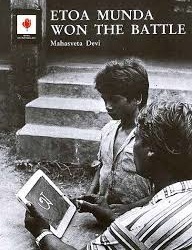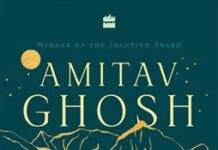BOOK REVIEW
Stories are indeed the most fascinating pedagogic tools. With their narrative, characters and story line how beautifully they unfold life’s deepest treasures. Here is a review of a fascinating book by Mahashweta Devi which speaks about the challenges of a young boy.
Author : Mahasveta Devi (Tr. Meenakshi Mukherjee), NBT, 1989, New Delhi
Uttra Bhansali

“I falter….I falter….yet, I want to walk..”
Battles which the Etoa fight, one realises, are also symbolic of the dilemmas, helplessness which probably each one of us face at times. Yet, with extreme perseverance and strength he faces them all and eventually wins. All the learning in life is not only through books alone. Etoa’s journey of life indeed reassures this.
The way he let himself learn from every situation which comes across his way and grows mature at such an early age is remarkable. His resistance is evident in his silence, intense engagement with the trees, the river, the sky, his empathy and understanding towards his responsibilities, leave an everlasting impression upon the reader. His inclination towards learning, curiosity to know, to be able to understand, doesn’t let him give up and eventually helps him to be able to fulfil his dream to study, something which he longs for. And this he achieves after having won the battles and challenges which he faced almost every single day.
Mahasveta Devi’s story of the little Etoa is remarkably lucid, yet promises an in-depth engagement and a sense of relatedness which every reader probably longs for. Believe me, it’s not just once, twice or thrice but so many times that you could imagine what Etoa imagines, you could feel what he feels, his dilemmas become your own and so does his excitement as well as his agony.”School seemed like a dream. The branch of the mango hadn’t only broken Mangal’s leg, it had shattered Etoa’s world.” And you too could feel the immense pain and helplessness just the way Etoa might have felt.
“But you’ve to remain alive till I grow up and go from this school to the school at Mohini where there is a hostel. One day I’ll be a school – teacher. If you don’t live long enough to see this, I’ll never talk to you, Aba.” In fact, one ends up dreaming with him, so many times, just the way he does. And one rejoices with him while he addresses the Dulang river, ” You’ll see now, you’ll see. Everything is going to change. Our teacher is wonderful, do you know that?” Or yet again, when he shouts it out to the sky,”Once I learn to read, I’ll find out all about them.” Etoa’s sense of curiosity and hope comes alive and is evident in his numerous conversations with the forest, the river , the sky and the grass.
The depiction of the community life in the story helps us understand the tribal way of life. Their sensitivity and closeness with Nature is quite evident in their everyday life practices. They worship the trees while celebrating their festivals, and ask for forgiveness to Mother Earth before “striking the spade on the ground” while arranging for a wedding. They long for the dense forests. “….The new bridge across the Subarnarekha might be of some benefit but whatever forests we have will disappear; we will be left with a desert.”
One also realises that it’s not the lack of awareness towards education but the economic helplessness which force their children into becoming cow herds at an early stage instead of going to school.”Yes, I will. But, Master, please see that the boy learns to read and write properly. I also wanted his father to go to school. But when the adivasi doesn’t have land, he doesn’t have food in his kitchen either.
That’s why we have to send our boys to work in the Babu’s house.” They not only understand the importance of education but also acknowledge the fact that illiteracy is the major cause of suffering in the lives of adivasis. Etoa’s grandfather tells the school master,”Beacuse we didn’t know how to read and write and were afraid of the law courts, the Babu’s gradually took every thing away from us-our land, our cattle…”
Etoa’s relationship with his grandfather, Mangal, has been beautifully depicted in the story. Undoubtedly, Mangal’s consistent insistence and efforts is one of the most important reasons behind Etoa been finally able to join the school. His excitement and affection knows no bound and he buys a fish to celebrate his grandchild’s first day at school. “Just a little. Your first day at school deserves something special.” Not only that, he also plays an important role in convincing others to send their children to school. In one of his conversations with his school friend, he asserts,”How long will this go on? For one meal a day, a few clothes and a portion of paddy our children remain illiterate. The whole world is moving forward but the adivasi children will remain where they are-illiterate and ignorant.” Undoubtedly, Mangal and the school master both play a crucial role in encouraging Etoa not to give up on studying. But, the way the writer outlines Etoa’s journey, one notices that Etoa too has had been a teacher to himself. It’s remarkable the way he manages to pause and listen to the stories the school master narrates to the children, think aloud about them while on his way to work, accepts his responsibilities, takes pride in the tribal history and convinces himself that they are not barbarians and their lives too have a different meaning. We thereby witness Etoa evolving by the way he accepts the circumstances at his end, understands his responsibilities and yet attempts to know, to study.
Mahasveta Devi’s story of little Etoa also helps us understand that the tribal community is a close-knitted one. Their willingness in sharing each other’s responsibilities is evident so many times in the story. When Etoa turned an orphan at the age of one, from an elderly aunty of the village to Mangal’s friend’s wife who already had two children, all came forward to take care of him. Yet, an another instance strikes you, wherein Mangal asks Etoa to gift the mat the former wove, which would have fetched them “five or seven rupees in the market” otherwise. “You shouldn’t go to a wedding empty-handed, Etoa. Among adivasis marriage is a shared responsibility. Each one brings whatever he can afford.” Even for Etoa’s ear piercing ceremony, while Mangal couldn’t afford to feed the entire community, the other adivasis got with whatever they could-“rice,dal or vegetable,” in accordance with their custom. The careful observation and description of these instances by the writer in the story helps the reader understand and imagine life around Etoa and his consequent socialisation.
Story-telling is yet an another essential part of the tribal life. Their sense of pride, longing, nostalgia are evident in the way they narrate their history of heroism. And indeed it significantly encourages all to overcome the obstacles which come their way. ” Etoa’s small chest seemed to burst with pride. Primitive barbarians indeed! Do barbarians have a great hero like Birsa Munda? Etoa seemed to grow taller with happiness and joy. No, Etoa knew they weren’t barbarians. Their livescouldn’t be limited to being cow herds and field labourers. Etoa would study and find the answers to the questions that plagued him…..”
What again strikes the reader are the beautifully captured pictures in the book which speak so much themselves. Those eyes, the smiles, the gazing towards the infinite, lying by the side of the river, it feels as if it’s all alive in front of you. One could very well imagine Etoa’s intense conversations with the sky , the river, the tall trees and consequently with his own self. ” Do you know what a fierce battle it was?”Indeed it was, a battle, which Etoa fought and eventually won,without being aware of. “Etoa Munda, too, was a brave warrior. He was also fighting a battle, only he didn’t know it.”
The story of the little Etoa is a beautifully written and an aptly translated one. Imagining the dialogues which keep taking place in the story is so easy and fills you with joy. “….There he danced and lifting his hands to the sky called out to the river, the reed forest and the flying birds, “Listen,” he said, “it was a fierce battle and people fought it. Do you know our Birsa and Sindhu, and our Kanhu. Do you hear?”…….The waves of the Dulang river carried Etoa’s words to the Subarnarekha. On the horizon the Rameshwar temple seemed to lean forward to hear them, and the striped grasshoppers hopped from flower to flower to Etoa’s story.”
It takes the reader too into a world of reflection, which Etoa too unknowingly keeps engaging himself with. Singing aloud and conversing with the trees, the river and the sky, as one understands, helps Etoa to reconcile with the challenges he keeps facing. It also probably helps him to restore faith in himself , gather strength and walk again.
It’s noteworthy here that Etoa’s story is so simply written, yet is so enlightening. Etoa’s journey becomes your own journey. And believe me, it is indeed a journey of evolution. As a parent, I eagerly look forward to introducing Etoa to my child.
Uttra Bhansali has completed her M.Phil(Sociology) from JNU( 2008-2010).
This article is published in The New Leam, April Issue( Vol.2 No.11) and available in print version.













